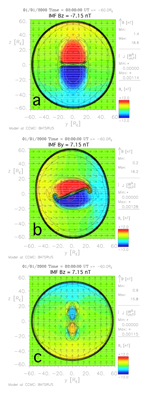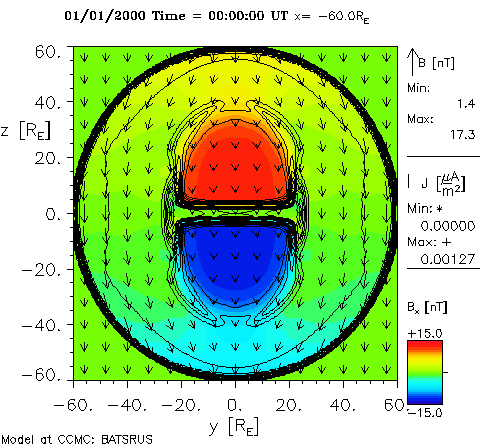2014 ARTEMIS SCIENCE NUGGETS
Size and shape of the distant magnetotail
by David Sibeck, NASA GSFC
Introduction
The solar wind transports magnetic field lines reconnected on the dayside magnetopause antisunward, depositing them into the Earth’s magnetotail. Magnetohydrodynamic (MHD) theory predicts that reconnection transforms the sharp tangential discontinuity dayside magnetopause into a broad slow mode fan bounded by a rotational discontinuity along the magnetotail flanks. The newly reconnected magnetic field lines exert a torque that twists the cross-tail plasma and current sheets out of the ecliptic plane. Anisotropic pressures flatten the magnetotail in the direction transverse to the component of the interplanetary magnetic field (IMF) in the plane perpendicular to the Sun-Earth line.
Once a month, the Moon and the two ARTEMIS spacecraft that orbit it, pass through the Earth’s magnetotail, affording an opportunity to observe and quantify these phenomena. To prepare for these observational studies, we employed the University of Michigan’s BATS-R-US model run at GSFC’s Community Coordinated Modeling Center with enhanced spatial resolution to predict the properties of the distant magnetotail as a function of varying solar wind conditions.
| Figure 1. Magnetotail cross-sections at X -= -50 RE for IMF By = 1, 3, 5, and 7 nT. Colors indicate the strength of the component of the magnetic field along the Sun-Earth line (Bx). Arrows indicate the components of the magnetic field in the Y-Z plane, perpendicular to the Sun-Earth line. Contours indicate electric current strengths. As the strength of the duskward By component increases, the north-south dimensions of the magnetotail diminish, the east-west dimensions increase, the current sheet separating sunward and antisunward magnetotail magnetic fields tilts out of the equatorial plane, and the north-south extent of the bow shock (as indicated by solid black contours) increases. |
Results
As illustrated in Figure 1, increasing IMF strengths progressively flatten the magnetotail cross-section at lunar distances. Since the IMF typically lies near the equatorial plane, so do the elongations. The tilt in the cross-tail plasma and current sheets is particularly noticeable. The north-south dimensions of the bow shock increase, while the east-west dimensions decrease.
| Figure 2. Magnetotail cross-sections for southward, duskward, and northward IMF orientations. For southward IMF orientations, the magnetotail cross-section is elongated north-south, for duskward IMF orientations east-west. For due northward IMF orientations, magnetotail magnetic field lines disconnect from the Earth. In the latter scenario, magnetic fields point antisunward north of the ecliptic plane, sunward south of the ecliptic plane. |
Figure 2 demonstrates how the IMF orientation controls the size, shape, and structure of the magnetotail cross-section. As the IMF rotates from southward (a) to duskward (b), the current sheet tilts out of the ecliptic plane and the east-west dimensions of the magnetotail increase. For due northward IMF orientations, magnetic field lines within the distant magnetotail disconnect from the Earth and exhibit a reverse lobe pattern, with field lines pointing sunward south of the equator and antisunward north of the equator.
| Figure 3. The response of the magnetotail cross-section to an abrupt rotation of the interplanetary magnetic field from southward to duskward. Parameters are similar to those shown in Figures 1 and 2. The magnetotail requires some 10-20 minutes to reconfigure. |
Figure 3, a movie, shows how the magnetotail size, shape, and structure vary when the IMF rotates abruptly from southward to duskward orientations. The IMF discontinuity first reaches lunar distances near the bow shock, then propagates inward towards the magnetotail axis. Some 10-20 minutes after it first appears at lunar distances, the transformation from a north-south to an east-west elongated magnetotail is complete.
Conclusion
Global MHD models predict the size, shape, and internal structure of the distant magnetotail. These predictions will provide a framework for two-point ARTEMIS surveys of the magnetotail at lunar distances.
Reference
Sibeck, D. G. and R.-Q. Lin, Size and shape of the distant magnetotail, J. Geophys. Res., 119, 1028-1043, 2014.Biographical Note
D. G. Sibeck is the THEMIS/ARTEMIS Mission Scientist at NASA’s GSFC. His wife, R.-Q. Lin works at the David Taylor Laboratory.
 Please send comments/suggestions to
Emmanuel Masongsong / emasongsong@igpp.ucla.edu
Please send comments/suggestions to
Emmanuel Masongsong / emasongsong@igpp.ucla.edu


